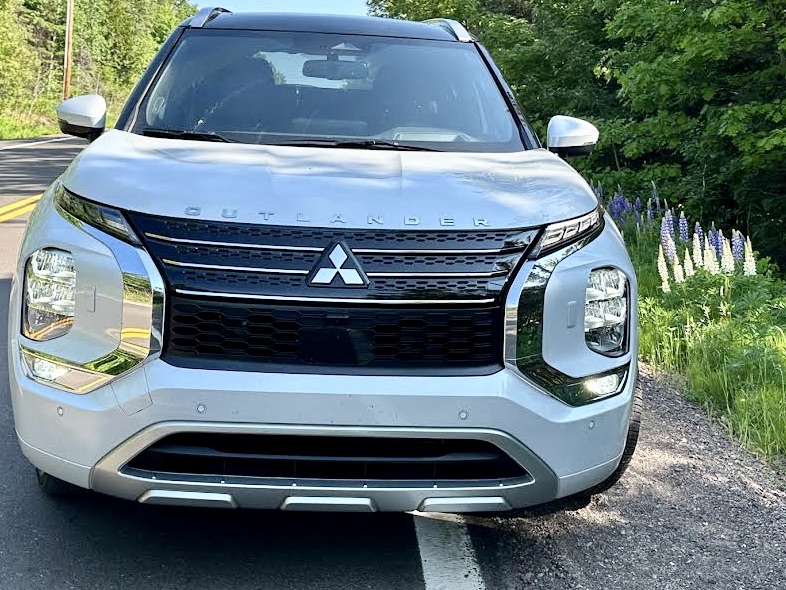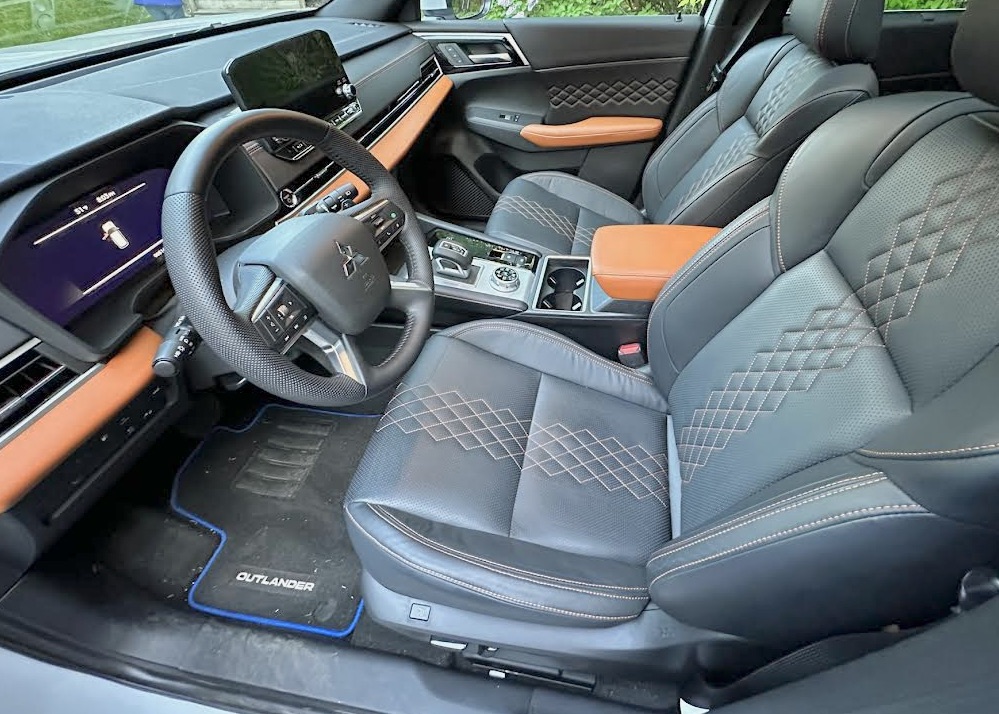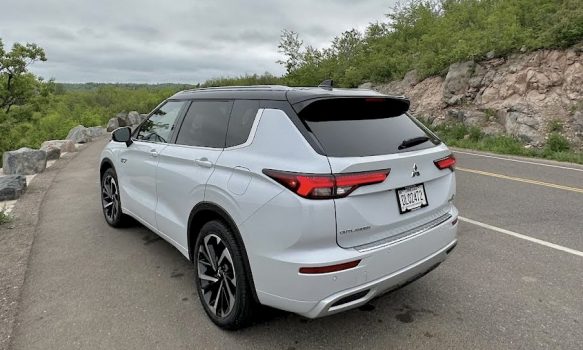Mainstream Outlander moves upstream
By John Gilbert
At a glance, the 2023 Mitsubishi Outlander Ralliart SE is a surprise to your senses. At first, from the front, its uniquely-sculptured hood and fenders encircle the headlight enclosures and make it look a little like a bug-eyed monster with too much mascara.
But don’t worry about the frontal appearance — it grows on you. Even in as short a time as one week, which matches the test-drive span I drove the vehicle, you reach the point where it doesn’t bother y9u anymore, and then you actually start to like it.
Mitsubishi has always been full of surprises in the 50 years it’s been bringing vehicles from Japan into the U.S. for sale, and in retrospect it seems a shame that the company didn’t come in by itself at the same time Honda, Toyota, Nissan, Mazda and Subaru were breaking into the U.S. market. Instead, Mitsubishi hooked up with Chrysler Corporation and in truth pretty much saved Dodge, Plymouth and Chrysler from major struggles.
Slow-learning consumers might have scorned those first Japanese imports, and Chrysler fans might have joined them saying the Dodge Colt subcompact was better than those Japanese competitors, but of course, the Colt was built by Mitsubishi, as was the Plymouth Champ. The Colt also came in a station wagon, and when Japanese competitors discovered the versatility and popularity of minivans, Chrysler held all the aces with the Dodge Caravan and later the Plymouth Voyager and Chrysler Town & Country. Those were company-saving vehicles, but a lot of folks didn’t realize that the main reason for their incredible durability was their amazingly smooth-running 3.0 V6 — built by Mitsubishi.
We could go on, into fun cars like the Eagle Talon and Plymouth Laser versions of Mitsubishi’s Eclipse sporty coupe, or the fantastic Dodge Stealth twin of the Mitsubishi 400 GT. But anyway, Mitsubishi never gained the same popularity or fame it might have had on its own, similar to its elite stature with its MGA television and electronics.
That was all back 50 years or so, while the biggest surprise of the last decade is that Mitsubishi is still hanging in there, building innovative vehicles and engines and fighting a truly uphill battle against the rising tide of technology all over the world. But the Outlander is leading Mitsubishi back to SUV popularity. A dozen years ago, Mitsubishi joined Chrysler for a joint venture with Hyundai, and the South Korean upstart began making a superb 2.4-liter engine that all three companies used — and still use.
A year ago, Mitsubishi restructured the Outlander, putting it on a new platform that is the result of another join engineering venture with Nissan and Renault. It was a brilliant move by Mitsubishi, which was adequate before, but now rides on the same platform as the hugely popular Nissan Rogue, and the new Outlander has a 33 percent improvement in torsional rigidity over its predecessor.
With all the right parts in place, the 2023 Outlander Ralliart SE underwent the refinement of a stunning interior, with impressive instrumentation and the luxury of quilted leather bucket seats, stitched to perfection and willing to house seven occupants in comfort and support, to celebrate the vehicle’s 40th anniversary. Well, for certain four or five of those seven will be comfortable; the third-row seat is mainly for youngsters and will spend most of its life probably folded down to increase storage space.
But at least there is a third row if needed.
Under the hood there is a refined version of that joint-venture 2.4-liter four-cylinder gas engine, and it is coupled to a hybrid system consisting of either of two battery arrangements, one with a single electric motor, or a two-motor deal with the two operating each rear wheel for a combined 248 horsepower instead of 132. The same set-up also boosts the torque figure up to 332 foot-pounds, above the standard 188.
The transmission gives you a “choice” between a CVT (continuously variable transmission) and an 8-speed — by giving you both. The CVT has detents built into its belt to simulate eight different gears, and you get steering wheel paddles to facilitate manual control of shifting.
You also can engage “One-pedal driving,” which uses the regenerative braking from the plug-in hybrid electric power to instantly help control your deceleration. So you can almost eliminate ever using the brake pedal, simply use the gas pedal to go and maintain speed, and when you see a stop ahead, you let off the gas and the Outlander slows down by itself, and will actually come to a compete stop, unless you feel the need to step on the brake to slow more quickly.
For a fully loaded price of about $50,000, the Outlander has about every contemporary feature you might want, and a few others don’t have. For example, the plug-in hybrid will accept a Level 3 high-speed charge station, something rare or not found in other three-row SUVs. You can avoid the plug-in and let the regenerative power do its thing alone, but using both can easily lift you up into the high-mileage elite.
Mitsubishi also puts its stamp on its unique all-wheel-drive system, calling it “S-AWC,” for “super all-wheel control,” using the gas engine for front-wheel power and the electric motors to help the rears keep up. It also enhances cornering, and gives the Outlander near sports-sedan agility.
Similarly, Mitsubishi rounds up all its impressive driving aids and puts them into “Mi-Pilot Assist,” which coordinates adaptive cruise control, lane keeping assist, forward collision warning and mitigation, blind spot warning, lane departure warning and prevention, and rear cross traffic alert. And you can stay in touch with everything the Outlander is doing because it has a 12.3 inch digital information screen.
With the battery electrical power fully charged, you can switch it to drive pure electric, or combine the gas-engine power with the electric motor power to zip onto freeways or into congested traffic. You can use pure electric for 34-40 miles of range, and you can bolster your mileage with judicious use of the traction settings. A knob gives you the choice of power, eco, normal, tarmac, gravel, snow, or mud, and you can easily reach 50 miles per gallon, and even reach 60 mpg.
And all of that while in comfort and health. The air conditioning includes an air purifier, which is the perfect thing in this summer of trying to breathe around the Canadian wildfire smoke wafting down into our airspace.






 John Gilbert is a lifetime Minnesotan and career journalist, specializing in cars and sports during and since spending 30 years at the Minneapolis Tribune, now the Star Tribune. More recently, he has continued translating the high-tech world of autos and sharing his passionate insights as a freelance writer/photographer/broadcaster. A member of the prestigious North American Car and Truck of the Year jury since 1993. John can be heard Monday-Friday from 9-11am on 610 KDAL(www.kdal610.com) on the "John Gilbert Show," and writes a column in the Duluth Reader.
John Gilbert is a lifetime Minnesotan and career journalist, specializing in cars and sports during and since spending 30 years at the Minneapolis Tribune, now the Star Tribune. More recently, he has continued translating the high-tech world of autos and sharing his passionate insights as a freelance writer/photographer/broadcaster. A member of the prestigious North American Car and Truck of the Year jury since 1993. John can be heard Monday-Friday from 9-11am on 610 KDAL(www.kdal610.com) on the "John Gilbert Show," and writes a column in the Duluth Reader.